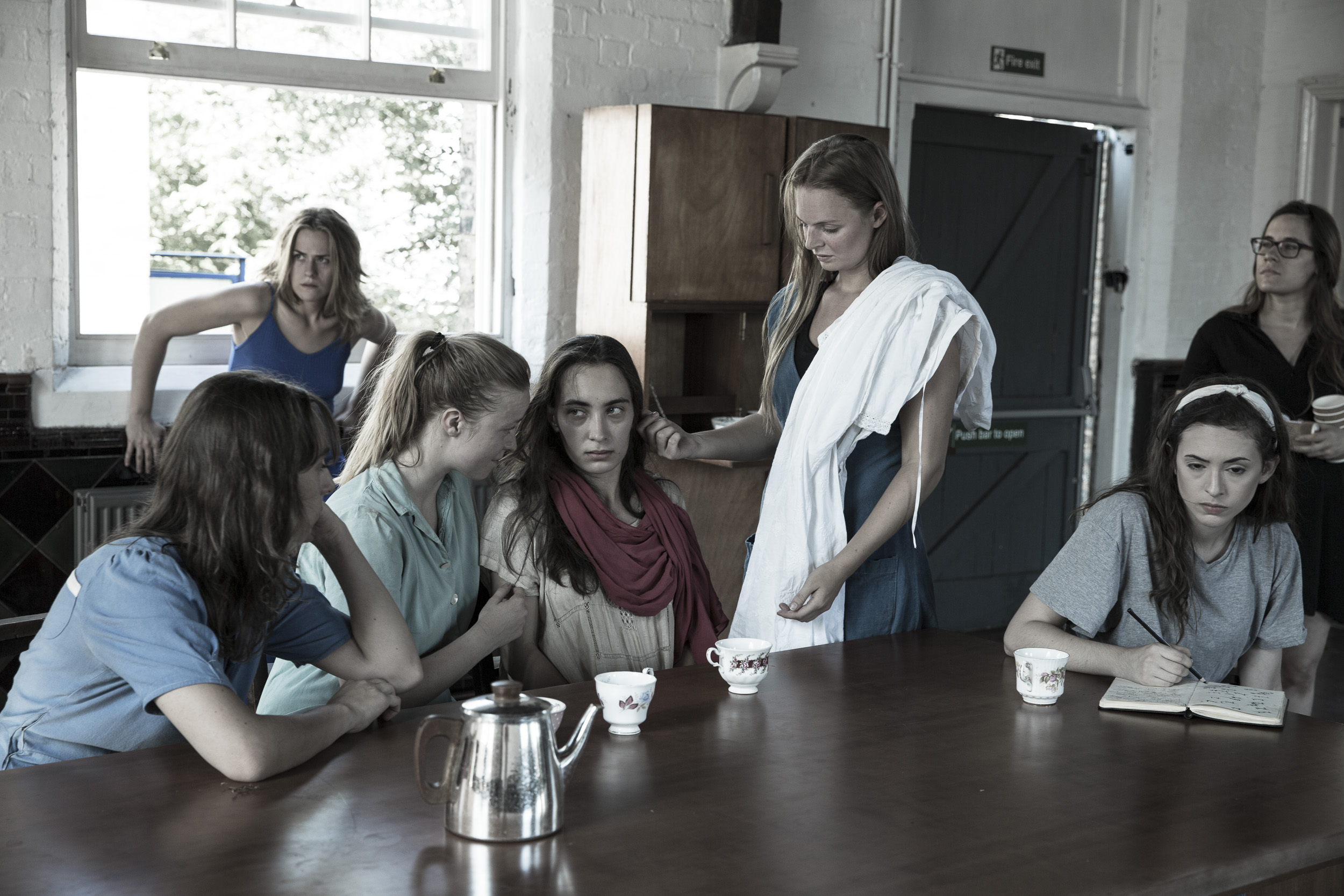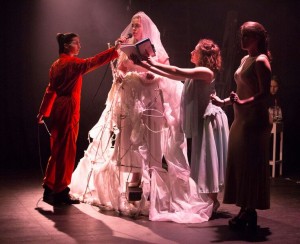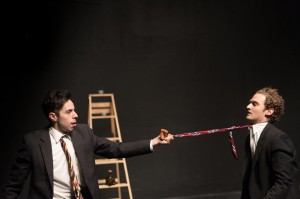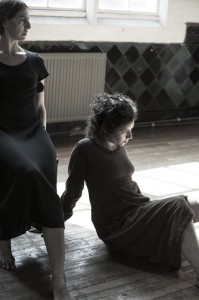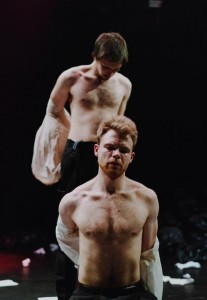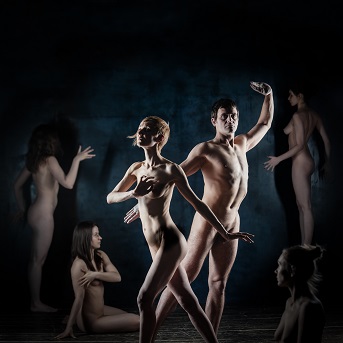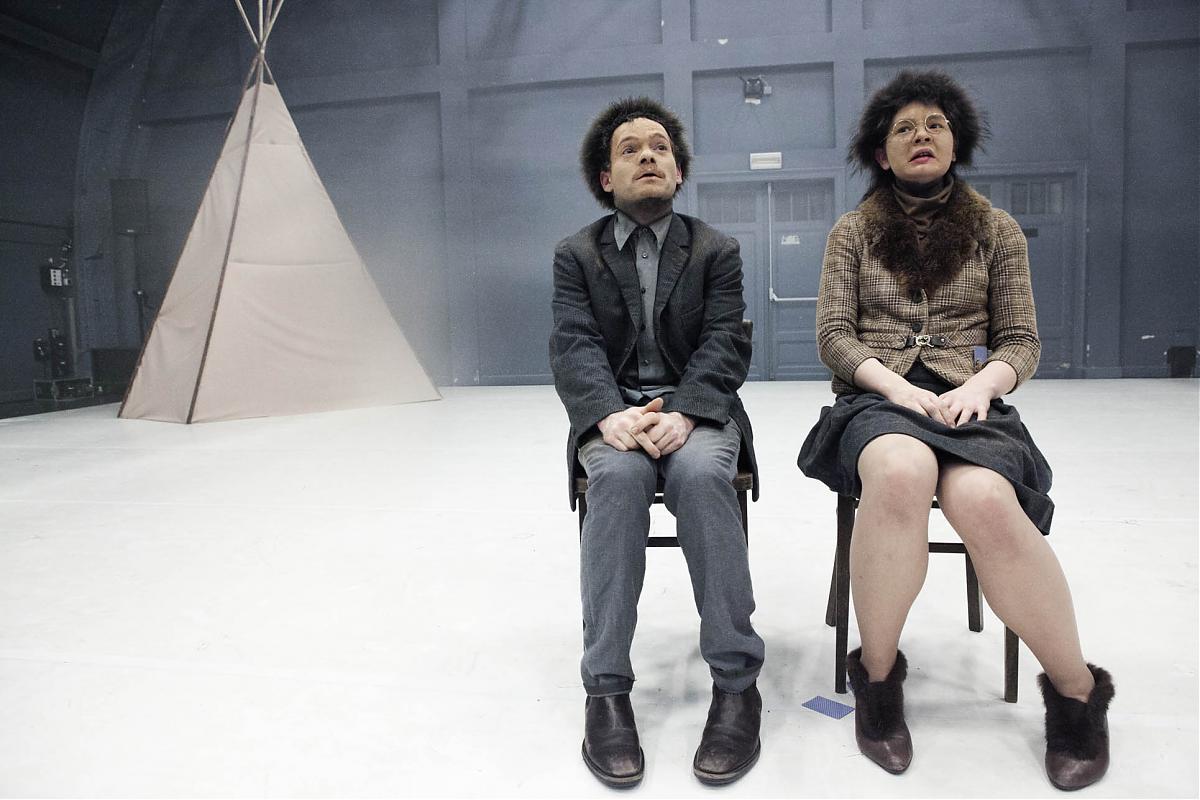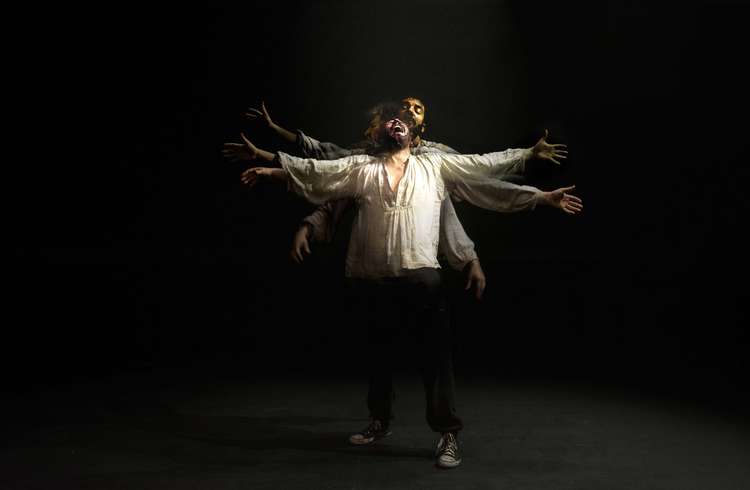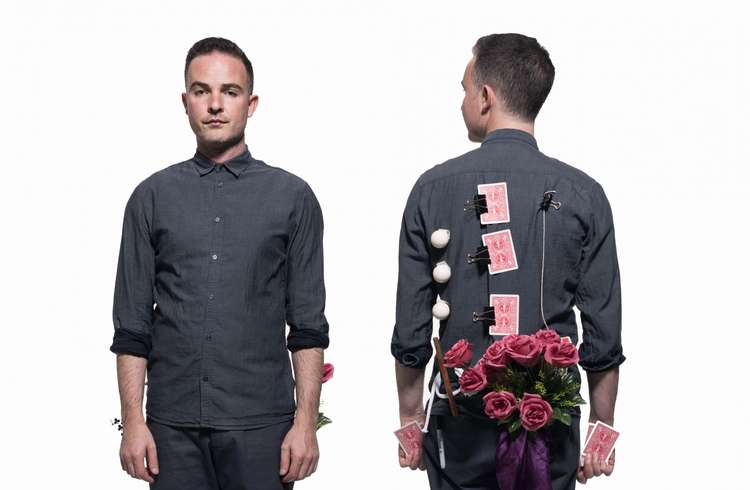Rose Bruford is blooming! Ciaran Hammond reflects on the College’s growing presence at Summerhall in Edinburgh – at the Fringe and beyond
It’s August, it’s the Edinburgh Fringe, and I’m running to Summerhall in the rain – forgetting that Edinburgh summers are a bit more overcast than London summers – with a vegetable pasty in one hand and too many show tickets in the other.
I jump up the stone steps, past four different people with soggy flyers in hand, and into the foyer. Once the wooden doors are hauled open, light cascades in through windows, silhouetting the wood and sandstone staircase – Summerhall always feels aged and fresh at the same time. As my eyes adjust I see posters on the foyer walls – Pussy Riot, Big In Belgium, Sh!t Theatre – and an array of small flyers with a mashed-up variety of different images. Then I’m out in the courtyard: in the middle of Summerhall’s grounds, there’s craft beer, a gin bar and mobile eatery. It’s a bit more like a London boxpark than a 19th century Scottish institution (Summerhall is a former veterinary surgeons’ college); nothing about this place is static or stuck in the past, and there’s always a forward-moving momentum carried by the venue.
I’m here to see work presented in Summerhall’s Upper Church – a space which, for the Edinburgh Festival Fringe 2018, has been programmed by Rose Bruford College under the banner Bruford in Summerhall. Student and recent graduate shows are presented side-by-side with oversees companies without official ties to the college (some as part of the Big in Belgium programme and others as independent companies) who are instead connected by a similarity in ethos and practice.
This is the third year of programming the Upper Church, but Rose Bruford has been collaborating with Summerhall now for seven years, enabling recent graduates, as well as those out of training for a number of years, to take performance work to the Fringe through their Jubilee scheme.
During my time as a student at Rose Bruford, on the European Theatre Arts course, I was in a collaborative learning space, with opportunities to work with students from various departments. As part of my Erasmus placement at EMTA in Tallinn, Estonia, the student group from Bruford that I was part of devised a physical theatre piece which we then performed back at the college in the spring of 2016. Before we knew it, we’d formed a company and were prepping to trek up to Summerhall for the 2017 Ed Fringe with a fleshed out and developed show, now titled The Crossing Place.
The Crossing Place was a theatrical exploration of the work of Swedish poet, Tomas Tranströmer, and was an experiment in the ‘can we do this?’ sense – no doubt a result of an adventurous spirit that was trained into us whilst at Bruford. Upon arriving at Summerhall, it became clear that the venue was fitting for the type of work that we had made: exploratory and experimental. To take the production here felt natural. There is a commonality in ethics and work approaches for performance-making shared between Summerhall and Rose Bruford College. Hopefully, Bruford’s expansion within Summerhall’s walls will enable it to grow in a direction that suits its collaborative and experimental identity.
So one year later, I am returning to the Fringe and to Summerhall, this time as a reporter. It is quite strange being on the other side of the fence, as it were – in 2017 me and my colleagues were running around the city, flyering almost 24/7 and attending press events to get reviewers in to see our show. So seeing three of the shows that formed part of the Bruford in Summerhall programme this year (Come To Daddy, The Last One, and Ur Medea) feels like a continuation, in some ways, of my life so far as a Rose Bruford graduate.
Originally devised within the BA (Hons) European Theatre Arts course at Bruford, Come To Daddy was created under the direction of Sleepwalk Collective’s Sammy Metcalfe. Come To Daddy is a young and fresh take on Sleepwalk Collective’s post-modern, ethereal style of performance. Audio drones are combined with slowly spoken text and daring lighting designs to create a concurrent sense of visual and sonic poetry throughout the piece. The piece examines the recurring themes in the work of Polish theatre director Tadeusz Kantor and the Cricot2 Theatre. Moving through the 20th century’s big hitters of art and performance, Come To Daddy looks at their value, now, near the end of the second decade of the 21st century.
The piece achieves this through combining aesthetics of the old and new: midway through the performance, a recreation of Marina Abromavic’s Breathing In/Breathing Out (Death Itself) is underscored by Young Thug’s RiRi. A mirror is then held behind the embraced pair, providing different visual perspectives of the image by moving it to different positions, transforming our perception of what the image is and what it means. This examination of old and new is something that extends into the formation of the company and the origins of the performance. Metcalfe graduated from Rose Bruford twelve years ago, and returned in the beginning of 2018 to work as a visiting director on the Tadeusz Kantor focused module that produced Come To Daddy, and which Metcalfe undertook a decade ago.
There’s a sense of legacy that runs through the piece, which is also iterated in Metcalfe’s involvement in the project. When asked as to whether and how his Rose Bruford roots had an impact on the emergence of the theme of legacy in the performance, he says:
‘There was definitely a lot of stuff I was thinking about at the beginning around my relationship to Kantor’s work and the influence it’s had on my own work, and around my relationship to my training and what it was to go back to that 12 years later, but this line of thinking was mostly confined to my own initial route into the work and the show – once we were in the rehearsal room the work followed its own route, and the majority of the work came from the cast. There was absolutely a load of personal thoughts and emotions that were informing my initial approach that came out of returning to this project after so many years, and that were channelled in some way or another through the lens of Kantor’s own writing and creative process.’
When I saw Come To Daddy at Summerhall, the level of collaboration between Metcalfe and the cast was evident throughout, and my impression of the show, after gaining his insights, have taken on an autobiographical light around Metcalfe’s presence.
Legacy and combinations of old and new are also apparent within The Last One by Galiana&Nikolchev’s The Useless Room, the second performance I saw at the Bruford in Summerhall 2018 programme. This performance piece presents a violent and primal landscape where European and American interpretations of contemporary performance practices collide. The company have used the death of the final kauaʻi ʻōʻō bird to explore the philosophical anxieties of Polish philosopher Witkacy. Metal buckets filled with rocks swing backwards and forwards, with performers diving underneath them. Centre stage, a barefoot, petite woman attempts to balance on a crudely assembled pile of boulders without injuring herself.
The piece has an aesthetic similar to work of performance makers like Jan Fabre; the movement is precise whilst also free and liberating in its execution and deals with the highly conceptual aspects that it brings forward in the here and now, rooted in physical exploration. The company met while in residence at The Grotowski Institute, and there is a clear continuation of those Polish roots in the piece’s physical nature. These Polish roots are what got them to Summerhall this year. According to Rose Bruford’s Head of School of Performance, Niamh Dowling, who has taken up much of the programming for Bruford in Summerhall, The Useless Room were programmed due to their ‘physical approach to making theatre that is such a part of the ethos and history of programmes and staff at Rose Bruford College working on programmes such as BA(Hons) European Theatre Arts, MA Actor/Performer Training and BA(Hons) Actor Musicianship.’
Techniques that the company have inherited from The Grotowski Institute have not, however, stayed in stasis, but have been expanded by the company. Gema Galiana’s frantic and explosive movement sequences carry with them a Spanish flair, while the incorporation of text that exploits its American roots transforms Anthony Nikolchev and Julian Sandoval into beat poets, exchanging verse amongst decimated ruins. Upon watching, it is hard to decipher whether the American-ness of the text is down to the content itself or merely the dialectical contrast between the men’s speech and their Spanish co-performer, Galiana. However, what is certain is that the national identity of all three performer’s oozes into all aspects of the piece, while the Polish roots that their company’s practice is founded on are also visible. The Last One is a prime example of how a merging of national identities can produce a variety of interpretations of established theatre practices.
The final show I saw at Summerhall’s Upper Church, Ur-Medëa, is the end-of-year project of Bruford’s current MA Actor/Performer Training students. The performance is a contemporised re-telling of the Greek Myth of Medea. The patriarch of a household comes back from a war in a distant land, bringing his fellow soldiers and a trophy prisoner back with him. He is changed by the war and the piece follows the household navigating the new and unclear moral compass he brings with him. The piece, which features a sixteen-strong ensemble, is directed by course tutor Gabriel Gawin, and has implemented an approach rooted in Gawin’s work with Polish avant-garde company Teatr Pieśń Kozła (Song of the Goat Theatre).
While Ur-Medëa contains traditional folk songs and a physical language that is much engrained in Song of the Goat’s work, the performance steers into more contemporary approaches to plot structure and dramatic action as it progresses. Some scenes descend quickly and unexpectedly into absurdist realms; as the archaic and folkloric postures of the Georgian folk song singing performers are abandoned, a more modern comedic madness rises. After an unconscious girl is rolled onto the floor, actors sing dulcet harrowing songs, supporting the angered response of one of the women of the house as two ghostly figures writhe and contort in the background. Later on, the same woman becomes infatuated with a young soldier, begging him to sleep with her. The advance is too strong for the young man and the delicate consideration of physicality within the piece is replaced with an adolescent awkwardness and socially oriented comedy. This progression into absurdity in Ur-Medëa works effectively as a dramatic device, showing how a crisis can change and affect a household.
As part of the course, the MA Actor/Performer Training students went on a research expedition to Georgia’s Caucasus Mountains, to study traditional folk singing. Student and Ur-Medëa performer Therese Ramstedt comments on the impact that this expedition had on the devising process for the show:
‘Our research expedition to Georgia, and what we experienced there as an ensemble, also played its part in the final production – though perhaps more in an abstract sense of carrying the experience through our work with the piece rather than directly incorporating what we learned there.’
As well as appearing in spirit, as Ramstedt proposes, this carrying on of experiences, cross-generationally, is something that appears in Ur-Medëa’s content; as the patriarch’s trauma seeps into the life of everyone in the house, and a new, twisted outlook of pessimism takes over from the house’s old, family-oriented, positivity.
This combination of old and new is a quality that I felt present in all three shows I saw, as well as the entirety of the time I spent in the venue, pointing to what a hub for new and experimental work Summerhall is. With Bruford’s growing presence at the venue, it is exciting to see in what ways emerging theatre-makers can be stimulated, and what work it inspires them to make for the most exciting and vibrant arts festival in the world.
What sets Bruford in Summerhall apart from similar collaborations between other institutions and venues is that it allows emerging theatre makers to be in a space that is beneficial for their growth as artists, as well as fostering a setting that offers professional experience and exposure. As a young artist in 2017, sharing performance and rehearsal space with successful, mid-career artists was inspiring; and the opportunity to meet other young artists was a refreshing break into different social and artistic circles.
The college will also be extending its activities in Summerhall to outside of the Edinburgh Fringe, through the launch of their new Acting Foundation Course, hosted in the venue. Versions of the course have existed in the college’s main grounds in Sidcup (London) for a number of years, as well as at Quarterhouse in Folkestone. This geographical expansion is a promising venture for the college, having been ranked as the world’s top drama school for student mobility earlier this year by U-Multirank, which the college has achieved through American exchanges with partner institutions and the Erasmus+ scheme. Rose Bruford has proven itself to be an institution that understands and utilises the value of putting its students into environments that they haven’t experienced before – Summerhall has become a professional satellite of Rose Bruford College, and offers students a rich experience of life as a professional theatre practitioner.
So after spending a few days at Summerhall this August, I’ve walked away with a scope of a few particular lineages of contemporary performance. Somewhere between the spookily stoic aphorisms of Come To Daddy’s living statues, and the violent outbursts of The Last One, is the work I did with fellow students last year – I’ve been able to place the work we did with The Crossing Place into this net of theatre practice. Seeing where the piece fits in amongst the differences and similarities between these productions gave me a sense of where my roots as a theatre-maker stem from. The visibility of roots in the work programmed at Bruford in Summerhall is brought about by Bruford’s ability to maintain connections with graduates, encourage growth of networks and to create hubs that facilitate the growth of emerging artists.
Featured image (top) is Rose Bruford: Ur-Medëa at Summerhall, August 2018.
All quotes are taken from email interviews with the subjects by Ciaran Hammond (2018).
For full details of the Bruford at Summerhall programme 2018, see https://www.bruford.ac.uk/summerhall/
For more on Rose Bruford College’s Acting Foundation Course at Summerhall, Edinburgh see: https://www.bruford.ac.uk/courses/acting-foundation-course-edinburgh/

